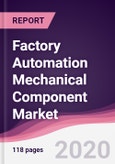What is Factory Automation Mechanical Components?
Mechanical Components are an indivisible module in a factory and industrial automation which are fabricated in a particular continuous order to execute a required function. These components are varied in size and design depend upon the function it performs.
What are the major applications of Factory Automation Mechanical Components?
Sensors are most significant contact or non-contact mechanical devices which provides information on absence, presence and strength of measured occurrences. These sensors plays vital role in HMI (Human Machine Interface), a software application which allows human to interact with manufacturing execution system. Controllers vary from the simple processor from complex controllers with multicore which analyses visualization, motion, safety, measurement functions, and logic of an automated system. It is predicted that, in small and medium enterprises this machine automation would make the production 30% faster and 25 % efficient. These efficiency of these machine automation can be measured and reported by linking it in to an ERP (Enterprise Resource Planning) system.
Factory Automation Market: By Mechanical Components
Market Research and Market Trends of Factory Automation Mechanical Components
Innovation & Development: Sensor-enabled rollers and belts which is capable to measure the quantitative metrics of an object, becomes contemporary material in the production planning. This sensor enabled rollers can weigh the products or collects other quantitative measures from the object as the pass on the belts, which in turn helps to minimize the errors and improves the consistency and quality of the output.
Mergers & Acquisitions: B&R, one of the predominant player in providing product and Technical based solution in industrial automation has been acquired by ABB, the market leader in the factory and industrial automation. This acquisition will provide global opportunities and expertise in large-scale technical and functional knowledge. It is expected that the sales target of B&R would reach more than $1billion in next fiscal year due to ABB’s commitment in B&R’s operational expansion, investment in R&D and other strategies to promote the business model of the company.
Investments Strategies: Recently, a largest organic investment was made by ABB, an industrial market leader in industrial automation, in Austria. This investment was around 100 million Euro to develop factory automation for future and to create 1000 new jobs. This investment is to build an innovation and training centers by the end of 2020. It is estimated that the company has decided to invest $1.4 billion every year for R&D purposes.
Who are the Major Players in market?
The key players operating in the Factory Automation Mechanical Components Market are 3M., ABB Ltd., Schneider Electric., Rockwell Automation., General Electric., Honeywell International., Mitsubishi Electric Corp., and other 10 more companies.
What is our report scope?
The report incorporates in-depth assessment of the competitive landscape, product market sizing, product benchmarking, market trends, product developments, financial analysis, strategic analysis and so on to gauge the impact forces and potential opportunities of the market. Apart from this the report also includes a study of major developments in the market such as product launches, agreements, acquisitions, collaborations, mergers and so on to comprehend the prevailing market dynamics at present and its impact during the forecast period 2017-2023.
Key Takeaways from this Report
- Evaluate market potential through analyzing growth rates (CAGR %), Volume (Units) and Value ($M) data given at country level – for product types, end use applications and by different industry verticals.
- Understand the different dynamics influencing the market – key driving factors, challenges and hidden opportunities.
- Get in-depth insights on your competitor performance – market shares, strategies, financial benchmarking, product benchmarking, SWOT and more.
- Analyze the sales and distribution channels across key geographies to improve top-line revenues.
- Understand the industry supply chain with a deep-dive on the value augmentation at each step, in order to optimize value and bring efficiencies in your processes.
- Get a quick outlook on the market entropy – M&A’s, deals, partnerships, product launches of all key players for the past 4 years.
- Evaluate the supply-demand gaps, import-export statistics and regulatory landscape for more than top 20 countries globally for the market.
Table of Contents
Methodology

LOADING...








